Lost Swedish civilian ships

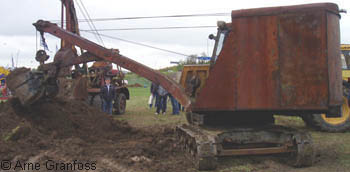 UNDER CONSTRUCTION Version 0.4
UNDER CONSTRUCTION Version 0.4
|
Sweden in World War II - across borders
|
 |
![]()
During World War II Swedish ships sailed for Sweden, the Allies, the Germans, the Red Cross and for some others.
 Around 1,400-1,500 Swedish sailors were killed when Swedish ships were hit by bombs, grenades, mines and/or torpedoes. (Plus or minus some hundreds - I've seen various numbers.)
Around 1,400-1,500 Swedish sailors were killed when Swedish ships were hit by bombs, grenades, mines and/or torpedoes. (Plus or minus some hundreds - I've seen various numbers.)
500-600 Swedish sailors were killed on ships from other nations.
Around 270 Swedish ships were sunk.
The Germans were skilled when it came to salvage and repair of sunk ships, and some of the sunk Swedish ships were back in traffic later.
The list of ships is not complete. Two of my three main sources for the table has focus on the iron ore traffic from northern Sweden to ports in among others the Netherlands, on ships in the 'granted' Swedish traffic between Sweden and among others the South America, and the Red Cross relief traffic from Canada to Greece.
Date is Month-Day.
![]()
1939
| Date and ship | Place (appr) and cause | Notes |
| 09-24 - s/s Gertrud Bratt | Skagerak - torpedo, German sub | In book [s64, 1999] it is told that the crew was allowed to leave the ship before she was sunk. (In book [s63, 1993] the same author wrote that she was sunk by a mine, and that 4 men were killed.) Another source: she carried wood, pulp and paper. |
| 09-25 - Silesia | Norway - German sub | |
| 09-28 - s/s Nyland | Norwegian coast - torpedo, German sub | First investigation by German officer about the destination of the iron ore cargo, then the Swedish sailors could leave the ship before it was sunk. |
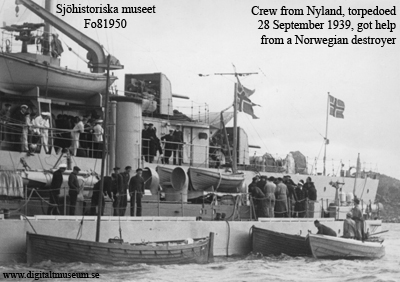
| 09-30 - s/s Gun | Skagerak - torpedo, German sub | |
| 10-08 - Vistula | Shetland - German sub | |
| 10-20 - Gustaf Adolf | 61.00N 00.48E - German sub | |
| 11-26 - Gustaf E Reuter | Shetland - German sub | |
| 12-02 - Rudolf | 56.15N 01.25 W - German sub | |
| 12-06 - Vinga | 56.25N 01.08E - German sub | |
| 12-12 - Torö | Near Falsterbo, Sweden - mine | |
| 12-18 - Lister | 55.13N 01.33E - German sub | |
| 12-21 - Mars | Iceland - German sub | Sunk by U21. Another source: 12-15 - Mars, Britain - German sub |
| 12-21 - Carl Henckel | 57.00N 00.17E - German sub | Sunk by U21 |
![]()
1940
| Date and ship | Place (appr) and cause | Notes |
| 01-01 - L.M. Trozelli | 54.14N 01.36W - German sub | |
| 01-03 - Svartön | North Sea - German sub | 20 men killed. Another source: With iron ore from Narvik to Middlesbrough, Britain. Torpedoed. |
| 01-05 - s/s Fenris | Gulf of Bothnia - S.U. sub | At least 2 women survived. |
| 01-13 - Sylvia | Scotland - German sub | |
| 01-18 - Foxen | 58.52N 00.22W - probably British mine | |
| 01-18 - Pajala | Hebrides - German sub | |
| 01-18 - s/s Flandria | 54.00N 03.40E - German sub | 16 men and 1 woman killed, 3 survived. Sunk by U9. |
| 01-19 - s/s Patria | 54.00N 03.30E - German sub (Earlier book: Dutch coast - 2 mines) | Sunk by U9. (Earlier book: 17 men and 2 women killed). (Other book: 18 men and 1 woman killed, 4 survived.) |
| 01-21 - Andalusia | North Sea - probably German sub | |
| 01-22 - Gothia | 57.46N 09.50W - German sub | |
| 02-01 - Fram | North Sea 57.43N 02.06W - torpedo, German sub | |
| 02-05 - s/s Wirgo | Åland - S.U. bombers | |
| 02-11 - Orania | Shetland - German sub | |
| 02-12 - Dalarö | 56.44N 11.44W - German sub | |
| 02-13 - s/s Norna | 55.30N 11.00W - German sub | |
| 02-16 - Osmed | Hebrides - German sub | Sunk by U14 |
| 02-16 - Liana | Hebrides - German sub | Sunk by U14 |
| 02-24 - Santos | 59.17N 00.42W - German sub | |
| 03-02 - Lagaholm | 59.34N 05.10W - gun on German sub | Crew left in lifeboats before the Germans began to shoot. |
| 04-10 - Sveaborg | 62.52N 07.34W - German sub |

| 04-14 - s/s Torne | Narvik - Germans opened valve in bottom of the ship | Crew left ship during fights in harbour. When visited later, the ship had been sacked. |
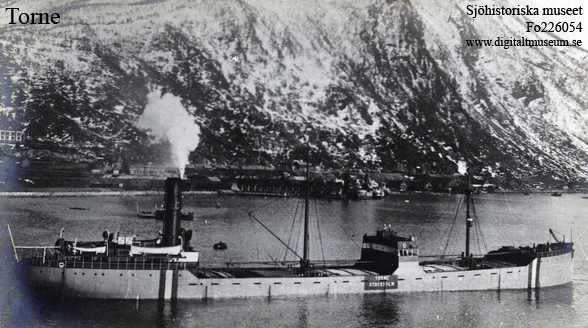
| 04-14 - s/s Styrbjörn (tug) | Narvik - Germans opened valve in bottom of the ship | Later salvaged and back in duty in Narvik. |
| 04-15 - s/s Boden | Narvik - Germans opened valve in bottom of the ship | Had also been sacked. |
| 04-22 - s/s Mertainen | Trondheim - German bombers | Pilots also used machine guns on deck and lifeboats. Was common during later air attacks. |
| 05-04 - s/s Monark | South Norway - British sub | Captured by Germans, on way to Hamburg. Investigated by British, and then sunk. |
| 05-08 - m/s Oxelösund | Narvik - German bombers | Had also been sacked. Later salvaged and back in the iron ore traffic. |
| 05-11 - m/s Stråssa | Narvik - German explosives | Germans bombers failed to sink the ship, despite several hits. |
| ?? - s/s Abisko | Narvik | |
| 05-19 - Erik Frisell | 57.25N 09.15W - German sub | |
| 05-28 - s/s Torsten | Kattegatt - mine, British or Swedish? | |
| 06-20 - Tilia Gorthon | 48.32N 06.20W - German sub | |
| 06-22 - Elgö | Mediterranean Sea - Italian sub | First torpedo missed, the sub used the 102 mm gun, and then sank Elgö with a torpedo. |
| 07-07 - Bissen | 50.06N 10.23W - German sub | |
| 07-17 - O.A. Brodin | 59.22N 03.40W - German sub | |
| 08-01 - Sigyn | 56.10N 09.25W - German sub | |
| 08-03 - Atos | 56.00N 07.00W - German sub | |
| 08-09 - Canton | Tory Island - German sub | |
| 08-13 - s/s Mongolia | Kiel area - probably British magnetic mine | British planes dropped many magnetic mines along the German coast, a hazard especially to ships with iron ore. |
| 08-13 - Nils Gorthon | Hebrides - German sub | |
| 08-16 - s/s Hedrun | West of Ireland 57.10N 16.37W - German sub | 8 men and 1 woman were killed. |
| 08-29 - Alida Gorthon | 56.09N 12.14W - German sub | |
| 09-26 - Siljan | Iceland - German sub | Sunk by U46 |
| 10-02 - Gondul | Near Limhamn, Sweden | |
| 10-18 - Canvallaria | 57.22N 11.11W - German sub | Sunk by U46 |
| 10-18 - Gunborg | 57.14N 11.00W - German sub | Sunk by U46. A Greek ship offered the Swedes to come onboard, but they said no thanks. Some minutes later the Greek ship was sunk by a torpedo. |
| 10-20 - m/t Janus | 56.35N 15.03W - German sub | Sunk by U46 |
| 10-27 - Meggie | Azores - Italian sub | |
| 11-09 - m/s Vingaland | 55.41N 18.24W - probably Italian sub | Vingaland was damaged after attack of German bomber on 11-08, and the Italian sub Marconi reported a damaged ship sunk on 11-09. |
| 11-17 - Veronica | 55.20N 08.45W - German sub | |
| 11-23 - s/s Anten | 56.57N 18.18W - German sub | |
| 12-02 - Gwalia | 39.22N 14.22W - German sub | |
| 12-04 - Daphne | Spain - German sub | |
| 12-12 - Stureholm | North Atlantic - German sub | |
| 12-21 - Mangen | 40.45N 16.50W - Italian sub | |
| 12-31 - Valparaiso | 60.01N 23.00W - German sub |
![]()
1941
| Date and ship | Place (appr) and cause | Notes |
| 01-11 - s/s Bertha | København area - probably British magnetic mine | 4 men killed. |
| 02-26 - Rydboholm | 55.32N 14.24W - German sub | |
| 02-26 - s/s Göteborg | Iceland - German sub | 9 men of Swedish crew killed, as 13 men and 1 woman from other nations. No one survived. Probably sunk by U70. Earlier the ship among others had transported British soldiers from Sweden to Britain, after the unsuccessful campaign in Norway in 1940, and in August 1940 she sailed from Lerwick (on Shetland Islands) to Petsamo (in northern Finland) with 124 Swedes from various sunk Swedish ships. |
| 03-05 - m/s Murjek (on or after 02-28, mentioned in the same book) | Faroe Islands - German sub | 14 Swedes killed, as crew from other nations. No one survived. 8 of the Swedes had worked on other sunk ships, and had signed on Murjek in Santos on her trip to Sweden. |
| 03-17 - Korshamn | 61.09N 12.20W - German sub | |
| 03-29 - Liguria | 60.00N 29.00W - German sub | 7 men survived. 10 men spent 5 days on a raft before rescued by British s/s Athenic, who was sunk by a torpedo the following day. This time the Swedes were rescued after a few hours together with other survivors. They were brought to a hospital in Liverpool, and the same night Liverpool was bombed. Another source: Carried coal from Dunston to Las Palmas. |
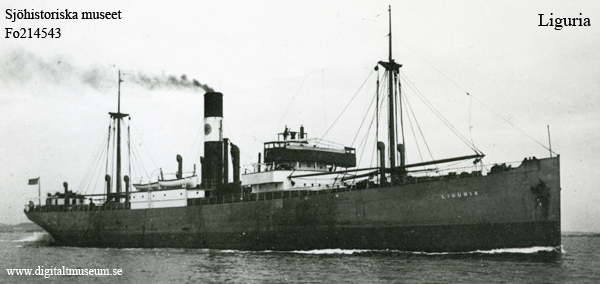
| 03-31 - m/t Castor | 57.59N 32.08W - torpedo, German sub | 15 men killed, 21 survived. Another source: On her way to Gothenburg, with oil from Port Arthur, Texas. Sunk by U 46. |
| 04-12 - m/s Kexholm | North Atlantic - German bomber | Crew survived. |
| 04-17 - m/s Venezuela | 53.00N 18.00W - torpedo, German sub | 41 Swedish crew killed, and 4 men and 4 women from Finland who were passengers. No one survived. On 04-10 a German plane had missed with 6 bombs, but close enough for detonations to cause some damages. A seventh bomb had gone through the main deck, but not exploded. Then the plane used its machine guns, but no one was killed. |
| 04-?? - m/s Trolleholm | Portugal - German ‘hijacker’ ship | Crew taken onboard German ship Thor, and explosives attached on Trolleholm. |
| 05-04 - Japan | West Africa - German sub | |
| 05-15 - s/s Ossian | German North Sea coast - torpedoes and bombs, British planes | 3 men killed. |
| 06-06 - Taberg | 35.36N 11.12W - Italian sub | |
| 06-22 - Calabria | Inishtrabull - German sub | |
| 07-05 - s/s Stig Gorthon | German North Sea coast - probably British magnetic mine | |
| 07-14 - s/s Aspen | Dutch coast - British bombers | Slightly damaged during nightly bomber attack in the Kiel channel, not hit during bomber attack the following night, but hit by 13 bombs (of which some did not explode) on 14th. One time-delayed bomb landed on the bridge, and was thrown over board where it exploded in the water. A German ship tried to tow the ship to Ijmuiden, but the ship leaked too much. |
| 07-28 - Norita | 40.10N 15.30W - probably torpedoes, German sub | After the attack U203 had to dive to avoid depth charges, but they reported torpedo detonations. |
| 09-11 - s/s Garm | 63.02N 37.51W - German sub | U432 shot two torpedoes and sunk one ship, which may have been Garm. One woman were among the survivors. |
| 09-11 - Scania | 63.14N 37.12W - torpedoes, German submarines | U82 hit with one torpedo, U202 hit with two torpedoes, and Scania sank. |
| 09-16 - m/s Yarrawonga | Hamburg - British bombers | |
| 10-21 - s/s Hilda | Dutch coast - British bombers | |
| 10-27 - s/s Gunlög | Dutch coast - British bombers |

| 11-01 - s/s Sigrid | Kiel area - British mine | 11 men were killed. As so often the lifeboats were damaged when the mine exploded, and this time also the extra raft on deck was damaged. Loaded with iron ore, she sank in 30 seconds. |
| 11-10 - s/s Vollrath Thamm | Dutch coast - British mine | |
| 11-22 - m/t Uno | Memel area in the Baltic Sea - probably German mine | The ship transported destilled water to submarine batteries. A German guard ship signalled, but the signals could not be understood - so the tanker sailed towards the guard ship, and hit a mine. |
| 11-23 - s/s Hedda | Cuxhaven - British magnetic mine | The ship had anchored in the harbour in dense fog, waiting for the fog to lift before berthing and unloading the iron ore. The following day a mine exploded at the aft. Probably the ship had turned around the anchor. |
On 05-25 s/s Trione was hit by British bombers in the North Sea. 3 men were killed, but the ship was not sunk.
On 06-06 s/s Ceylon was hit by British bombers in the North Sea. 1 man was killed, but the ship did not sink.
08-08 – s/s Venersborg was hit by British bombers in Denmark. 2 Swedes and 1 Dane killed. The Swedes had abandoned the burning ship, but Germans from another ship went onboard (Swedes were not permitted to go onboard) and they managed to tow the ship to land where the fire was put out. Later she was towed to Sweden, repaired, and went back into the iron ore traffic.
11-01 – s/s Braheholm was bombed near Rotterdam, and as usual the planes also used their machine guns. One man was killed. On the way to the Kiel channel the convoy was attacked by British bombers at several occasions. The ship arrived in Stockholm one week later.
11-02 – s/s Ingeren bombed near Rotterdam, and one man was killed. After some days at a warft she sailed on to Sweden.
11-23 – s/s Hastings seemingly caused a magnetic mine to explode a little too early, and only got a minor leak. After inspection she could continue to Sweden.
![]()
1942
| Date and ship | Place (appr) and cause | Notes |
| 01-12 - m/s Yngaren | 57.00N 26.00W - German sub | A Swede and a Dane survived, rescued after 28 days on a raft in the North Atlantic in the middle of the winter. |
| 02-03 - Amerikaland | 36.36N 74.10W - German sub | |
| 03-07 - s/s Skåne | 20.50N 62.05W - Italian sub | No one was killed. |
| 04-08 - s/s Ara | South of Cuxhaven - mine explosion midship starboard | Explosion tore up the heavy metal floor in engine room, bent the propeller shaft and damaged steam pipes. On deck the planking, a large part of the superstructure, and starboard lifeboat were damaged. The stove was thrown into the opposite wall. The cook was not there at the moment. One man in the machine room climbed over bulkheads to get out as hot steam filled the engine room and water rushed in through leaks. He managed to get out via the ‘propeller tunnel’. This man had experienced similar sinkings during WWI, and this was the third time he was on a ship sunk by mines during WWII. |
| 04-13 - Korsholm | 28.21N 80.22W - German sub | |
| 04-20 - s/s Arete | Denmark - mines | 4 men killed. Ship sank in three minutes. |
| 04-20 - Agra | 34.40N 69.35W - German sub | |
| 05-08 - s/s Ruth | Dutch coast - British bombs | Sunk in British bomber hit-and-run attack. British radar gave the Brits info about shipping along the enemy coast, bombers could reach the targets in 15-30 minutes and make low level bomb and machine-gun attacks, and leave before German fighters could reach the area. Ruth sailed in convoy that was attacked a number of times, and two other ships were sunk in the evening of the 7th. Ruth was hit by two bombs one hour before midnight, and despite efforts to save her she sank on the 8th. Another source: Ruth sailed from Rotterdam towards Gothenburg, with coal. |

| 05-13 - Tolken | 51.50N 33.35W - German sub | |
| 05-19 - Tisnaren | 03.38N 32.01W - Italian sub | |
| 05-30 - s/s Värmdö | Dutch coast - British bombs | 6 men and 1 woman killed. |
| 06-03 - Anna | 34.10N 68.22W - German sub | Anna was reported to lack Swedish neutrality signs and illumination, and to sail with zigzag course. |
| 06-09 - s/s Stureborg | Cyprus, Mediterranean Sea - torpedo or bombs, Italian plane | 16 Swedes, 2 Portugese and 1 Egyptian crew killed, and 1 Swiss Red Cross representative. 10 of the 20 in the crew managed to get onto a raft. Lack of water and food killed one after the other, and when the raft stranded near Gaza after 22 days only one man was alive. The ship sailed in the Red Cross aid for Greece, and was on the way to Haifa to fetch wheat for Greece. |
| 06-12 - s/s Bojan | Near Sassnitz, Baltic Sea - British magnetic mine | Towed towards land where she sank. Damaged both by the mine, as the cargo of paper pulp swelled, and by explosives used to unload the cargo. Sold as wreck, but reappeared as “Hoheweg”, in traffic for the rest of the war. |
| 06-12 - s/s Senta | German North Sea coast - British bombers | At least 2 women survived. The ship sank so fast that the lifeboats were not launched until the main deck was below the water. |
| 06-21 - s/s Eknö | German North Sea coast - mine | |
| 06-22 - s/s Ada Gorthon | East of Öland, in Swedish waters - Soviet Union torpedo | 14 men killed, 8 survived. Torpedo hit midship. The ship had 2,000 metric tonnes iron ore in the fore and another 2,000 in the aft - and sank in less than 30 seconds. |
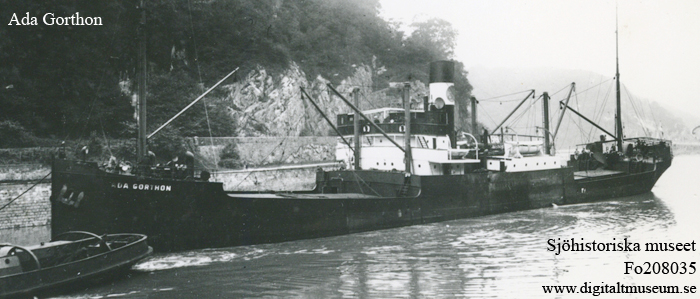
| 07-01 - m/s Eknaren | Indian Ocean - Japanese sub | |
| 07-06 - m/s Argentina | Skagerak - mines | 4 men killed. |
| 07-06 - m/s Uddeholm | Skagerak - mines | All rescued. Argentina and Uddeholm had sailed all the way from South America, and were close to Sweden. When questioned by Germans in Norway, it was discovered that published information about a change in the minefield had not been received by the Swedish captains. |
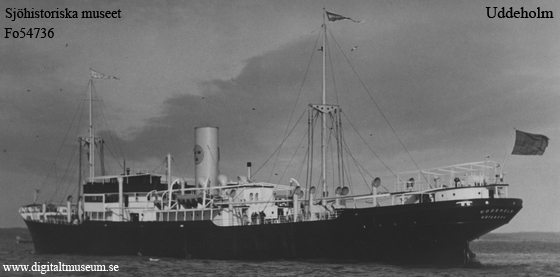
| 07-09 - s/s Margareta | North of Gotland, in Swedish waters - Soviet Union torpedo | 14 men killed, 4 survived. |
| 07-11 m/s Luleå | North of Öland, in Swedish waters - Soviet Union torpedo | 8 men killed. |
| 08-09 - s/s Sigyn | Dutch coast - mine | |
| 08-16 - m/s Suecia | 55.43N 25.58W - German sub | Another source: She was Swedens first dieselpowered ocean-sailing ship, built in 1912, one of the first large dieselpowered ships on the planet. She sailed for Britain, and was on her way to Liverpool. One lifeboat went down, with 9 men. |
| 08-18 - Blankaholm | 19.41N 76.50W - German sub | |
| 08-18 - s/s Liljevalch | North of Öland, in Swedish waters - Soviet Union torpedoes | 33 men killed, 7 survived. She was the first ship in a convoy of 16 ships (Swedish, German, Finnish and Dutch). She sank in 30-35 seconds. |
| 08-22 - Hammaren | 13.00N 38.15W - German sub | |
| 09-08 - s/s Tynningö | German North Sea coast - mine | |
| 09-09 - Peiping | 23.50N 50.10W - German sub | |
| 09-13 - m/s Lima | 02.35N 11.22W - German sub | |
| 10-01 - s/s Thule | Dutch coast - torpedo from British motor torpedo boat | 9 men and 1 woman killed. |
| 10-22 - m/s Remmaren | South Norway - mines | Crew rescued. |
| 10-29 - s/s Bengt Sture | Southern Baltic Sea - probably Soviet Union torpedo | 14 men and 1 woman killed. There are various indications that 5-7 of the crew were taken on board a Soviet Union submarine and brought to Kronstadt or Leningrad. Leningrad was under heavy German attack. Their fate has not come to clarity. |
| 11-06 - s/s Lidingö | Kiel area - British magnetic mine | On 1 April 1941 she had hit a mine in Swedish waters south of Sweden, and sank I 8 metres deep water. Salvaged and repaired, and back in traffic on 1 August 1941. |
| 12-13 - Scania | 01.36N 32.22W - German submarine crew | Boarding party sank the ship. |
| 12-14 - Etna | 17.50N 46.20W - torpedo, German sub | The crew was warned and left the ship before it was torpedoed. |
| ?? - s/s Urania | mine | At least 3 women survived. |
On 11-09 s/s Abisko was one of the ships in a German convoy from Rotterdam in the Netherlands. She carried coke. During the night British motor torpedo boats sank several of the ships. Abisko was damaged, and the crew left in lifeboats. The attack ended after some 15 minutes, and it was discovered that Abisko had stopped sinking. The crew returned, and they could sail the ship to Emden. The deck was close to the water, but a crucial bulkhead held and she could sail at top speed by herself. Three German tugboats assisted to yaw where the river was curved. A month later she was back in the iron ore-coal/coke trade. See below…
![]()
1943
| Date and ship | Place (appr) and cause | Notes |
| 01-01 - m/s Brageland | 00.19N 37.28W - German submarine crew (?) | Stopped, searched and sunk. |
| 01-09 - m/t Sveajarl | South Norway - mines | 37 men killed, 3 men survived. Also 7 men from m/s Ecuador who tried to help the shipwrecked from Sveajarl were killed. |
| 01-09 - m/s Brasil | South Norway - mines | Crew rescued. The ship sailed together with Sveajarl and Ecuador. |
| 01-13 - s/s Virgo | German North Sea coast - mine | 2 men killed. |
| 01-18 - s/s Algeria | Dutch coast - British bombs | 2 men killed. |
| 01-22 - Neva | 61.35N 14.15W - German sub | |
| 03-09 - Milos | 58.00N 15.00W - German sub | |
| 03-13 - s/s Hermod | German North Sea coast - torpedo from British motor torpedo boat | 3 men and 1 woman killed. |
| 03-25 - m/s Industria | 11.40S 35.55W - German sub | |
| 04-05 - m/s Vaalaren | 58.00N 34.00W - German sub | |
| 04-11 - s/s Abisko | German North Sea coast - mine | 1 man killed. |
| 04-29 - s/s Narvik | Dutch coast - British torpedo plane | |
| 04-29 - Nanking | 05.10N 11.10W - German sub | |
| 05-07 - s/s Sirvall | Near Sassnitz, Baltic Sea - British magnetic mine | An example of the power of the magnetic mines, which could cause enough damage to sink a ship even when it exploded 10-15 metres from the ship. |
| 05-20 - Sicilia | Indian Ocean - gun, German sub | Another source: 05-27 torpedoed by German sub U-995 along Mocambique |
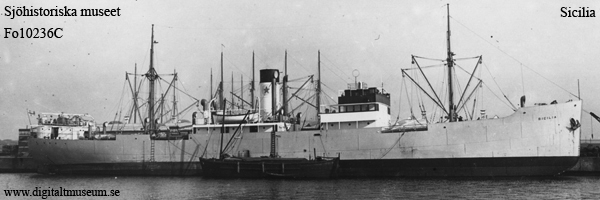
| 05-25 - s/s Haneström V av Göta | German Baltic Sea coast - mine | 2 men killed in hot steam leaking from broken pipes in the engine room. She sank in 24 metres deep water, but was salvaged and back in traffic in late August 1943. |
| 05-29 - s/s Gondul | German Baltic Sea coast - mine | She was on the way from Germany to Sweden, apparently with among others iron, cars and oranges. |
| 06-21 - Venezia | 25.50S 38.38W - German sub | |
| 07-10 - m/s Scandinavia | 08.28N 48.30W - German submarine crew | Stopped and sunk. |
| 07-19 - s/s Vidar | Dutch coast - British magnetic mine | |
| 07-24 - m/t Pegasus | Indian Ocean - German sub | |
| 07-28 - s/s Gapern | Hamburg - bomb attack on the city | 1 man killed. |
| 10-09 - s/s A.K Fernström | Gdynia - bomb attack on the city | |
| 12-29 - m/s Camelia | Saloniki harbour, Mediterranean Sea - mine, probably British magnetic mine | After explosion towed to shallow water, where she sank. She was later salvaged, and after provisional repair towed to Sweden where she arrived in mid September 1944. (Yes, it’s apparently true. My note.) |
![]()
1944
| Date and ship | Place (appr) and cause | Notes |
| 01-14 - Entrerios | Norway, near Farsund - air attack | On her way from Narvik to Germany. |
| 03-05 - s/s Diana | German North Sea coast - torpedo from British plane | 2 men killed. Polish and Soviet Union prisoners had loaded coke on Diana in the severly bombed Emden. Normally it took a week for ships to be unloaded and loaded, but in these times it could take up to two weeks. The torpedo explosion damaged both lifeboats and the raft in the fore. The ship sank in 3 minutes. A few minutes later the survivors were rescued by a German escort ship, where they were well treated. |
| 04-11 - s/s Emily | Stettin - bomb attack on the city | Crew had not time to leave for shelters in the harbour, but were in the stern. A bomb exploded on the ship 15-20 metres further to the stem. |
| 04-19 - s/s Tärnan | Near Lübeck - magnetic mine | 2 men killed. |
| 04-19 - s/s Embla | French Mediterranean Coast - British bombers | On 04-06 she was set afire by a British bomb, near the French-Spanish border. After provisional repair she left Port Vendres on 04-19, and was sunk by two British bombs. She was marked with among others Red Cross symbols. |

| 05-13 - BT-V (tanker) | Stettin - bomb attack on the city | 4 men killed. The ship had almost finished the loading of lubrication oil, this time for Sweden. (She had freighted oil to German submarines in the Baltic Sea many times.) |
| 06-13 - m/s Fenja | Turkey - mine | Fenja made her maiden voyage in March 1944, and was sunk on 13 June 1944. |
| 06-29 - s/s Libau | Near Sassnitz, Baltic Sea - British magnetic mine | 1 man died the following day. |
| 07-06 - m/t Solbris | German North Sea coast - mine | |
| 07-08 - s/s Sif | German North Sea coast - torpedo from British plane | She sailed from Emden in a convoy with 3 Swedish, 2 German and 2 Dutch ships. The convoy was escorted by 8 German naval ships, among them 2 destroyers. Some 30 planes attacked, and several were shot down. 3 merchant ships were sunk, and there were damages on escort ships. |
| 08-12 - s/s Nämdö | German North Sea coast - mine | 4 men killed. She had made around 50 trips to and from Germany. (On 29 May 1942 she sailed in a convoy behind s/s Värmdö from the same shipping company, when that ship was sunk. One bomb hit the gunwale on Nämdö and went overboard before it exploded. The side of the ship got damaged, but she could sail on. When the plane came back for another attack it flew so low that one wing hit the foremast on Nämdö, and the plane fell into the sea and sank.) |
| 09-06 - s/s Rosafred | German North Sea coast - torpedo from British plane | Due to the growing risks for the crews and ships, this was planned to be her last trip to Germany with iron ore. Around 30 planes attacked the convoy, and they no longer had to fear German fighters intercepting. Another source: She was on the way from Emden towards Stockholm, with coal, and sailed in a German convoy. |

| 11-24 - s/s Hansa | Between the Swedish mainland and the Swedish island Gotland - torpedo from Soviet Union sub | 84 people killed. Another source: It was earlier believed that the attack on this passenger ship was a mistake, but in 1993 it was disclosed that the shipping company who owned Hansa transported German soldiers and equipment in 1944. Maybe that was known by the submarine captain? |
| 12-29 - s/s Venersborg | Southern Swedish Baltic Sea coast - torpedo from Soviet Union sub | 17 men and 2 women were killed. |
| ?? - s/s Svanen | mine | Crew survived, among others Märta Frese who had signed on in 1944. She was a pensioner at the time she signed on. |
| ?? - Vesta, fishing boat | Mine |
![]()
1945
| Date and ship | Place (appr) and cause | Notes |
| 01-xx - Beltana, fishing boat | Mine | 5 men died. |
| 03-14 - Magne | Scotland east coast - German sub | Another source: U-714. Magne was on the way from Liverpool to London. |
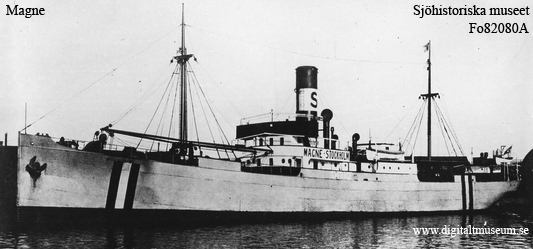
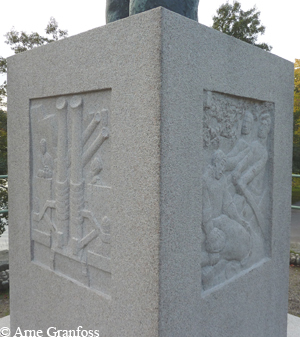
![]()
Main sources for the table: [s63] (foremost iron ore traffic between Sweden and Germany), [s64] (foremost traffic westwards) and [s65] (more general view). The books [s63] and [s64], by the same author, have some contradictory information.
2015-08-29. www.granfoss.se. Text/pictures: Arne Granfoss